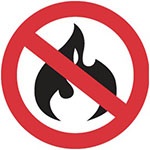Bushfires
Total fire bans Hazard reduction burns Cane burning Wildlife and bushfires Bushfire smoke Asset Protection Zones Emergency Dashboard
Bushfire danger period in the Tweed is from 1 September to 31 March.
Council is not the authority in emergencies.
Council rangers cannot attend to fires.
Total fire bans

During a total fire ban all fire permits are suspended and open fires are banned.
A total fire ban may be declared to reduce the risk of fires. Bushfires are more likely to spread and cause damage on days when the weather is very hot, dry and windy.
The fire ban includes the use of incinerators and barbecues (BBQs) with an open flame. Gas and electric BBQs may be used.
No welding, grinding, soldering or gas cutting can be done in the open during a total fire ban.
Avoid tractor slashing to reduce the chance of a fire starting on your property (recommended by NSW Rural Fire Service).
Read more about fire danger ratings and total fire bans on the RFS website.
Wildlife and bushfires
Wildlife can be injured or displaced as a result of bushfires. If you come across injured wildlife, call the WIRES hotline on 1300 094 737 or the Tweed Valley Wildlife Carers on 02 6672 4789 immediately.
If you find any sick, injured or orphaned koalas call Friends of the Koala on 02 6622 1233 (24-hour hotline)
See Friends of the Koala and fire and koalas
Cane field burning
Sugar cane burning season generally runs from July to November/December.
Sugar cane burning takes place before the harvest to make it easier to process the cane. It is a well-established agricultural practice and many cane farmers are experts in fire management.
Cane farmers have to apply for permits and must meet the requirements of the Rural Fires Act 1997. All complaints regarding burning of sugar cane are to be made to the NSW Canegrowers Association by calling 02 6645 2515.
Bushfire smoke and health
For health information about smoke from bushfires visit NSW Health and Asthma Australia.

How we manage bushfire risk on Council owned land
As a land manager Council has obligations under the NSW Rural Fires Act 1997.
During emergencies we coordinate with fire and emergency service authorities through the Local Emergency Management Committee.
Council owns or manages approximately 4470ha of bushland including:
- Byrrill Creek and Clarrie Hall Dam catchments
- Mount Nullum
- Tweed Coast Regional Crown Reserve
- Bushland reserves at Pottsville (Koala Beach, Pottsville Wetland and Pottsville Environment Park)
There are also many smaller areas of bushland in Tweed's towns and villages.
Asset Protection Zones
We maintain fire trails and Asset Protection Zones (areas of land between Council bushland and residential areas or buildings).
These buffer zones provide safe access for fire-fighters and emergency services. They are inspected each year before the Bushfire Danger Period.
As a resident, you must maintain your own Asset Protection Zone if you live in a bushfire prone area. This is the area around your home that will provide you with a buffer to an approaching bushfire. If you live in a rural area, it is essential that you have one.
See lighting fires and permits and preparing and planning for bushfires.
Hazard reduction burns
 A hazard reduction burn — also known as a prescribed burn or fuel reduction burn — is a planned fire deliberately started under controlled conditions to reduce the amount of ‘fuel’.
A hazard reduction burn — also known as a prescribed burn or fuel reduction burn — is a planned fire deliberately started under controlled conditions to reduce the amount of ‘fuel’.
Burning fuel on the ground (like grasses, leaf litter and fallen timber) reduces the severity of future bushfires.
If you would like to carry out bushfire hazard reduction work on your property, Tweed Fire Control Centre can provide advice. A permit and hazard reduction certificate may be required. Call 02 6671 5500
For a list of hazard reduction burns in your area see NSW Rural Fire Service
Climate change
Fire seasons are predicted to start earlier and end later due to climate change, with more frequent extremes of weather.
Far North Coast Bushfire Management Plan 2017
The plan identifies community, economic, environmental and cultural assets at risk of bushfire. It ensures a multi-agency approach to reducing risks to those assets.
The plan is reviewed and updated every 5 years (next review 2022).
Tweed Shire Council is the land manager for 1.89% (4470 ha) of the Far North Coast Bushfire Management Committee area.
Far North Coast Bushfire Risk Management Plan (2017)(PDF, 1MB)
Far North Coast bushfire maps
Bushfire risk management Committees
Local Emergency Management Committee
Council chairs the Local Emergency Management Committee. The Committee includes representatives from each local emergency service and supporting agencies. It is responsible for planning, preparation, response and recovery arrangements for emergencies.
Far North Coast Bushfire Risk Management Committee
Council is a member of the Far North Coast Bushfire Management Committee.
The committee is responsible for preparing, coordinating, reviewing and monitoring the Far North Coast Bushfire Risk Management Plan.
The committee covers Ballina, Byron and Tweed Local Government Areas and ensures a joint approach to bushfire management.